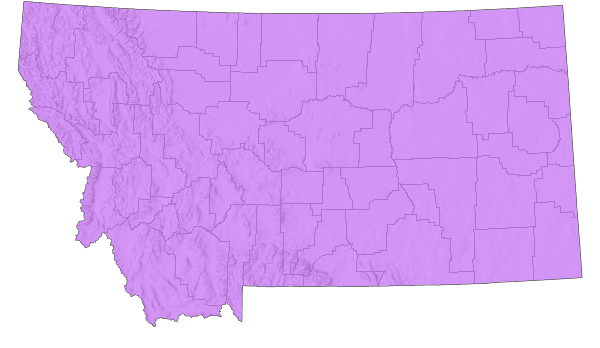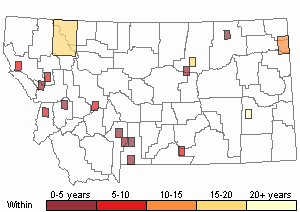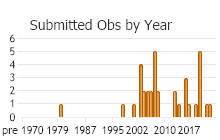View in other NatureServe Network Field Guides
NatureServe
Montana
Utah
Wyoming
Idaho
Wisconsin
British Columbia
South Carolina
Yukon
California
New York
Common Ringlet - Coenonympha california
Native Species
Global Rank:
G5
State Rank:
S5
Agency Status
USFWS:
USFS:
BLM:
External Links
General Description
[From Ferris and Brown 1981, Scott 1986, Glassberg 2001, Guppy and Shepard 2001, Pyle 2002] Forewing 1.5-1.9 cm. Highly variable. In the Rocky Mountains and Plains yellow-orange to orange-brown dorsally, green-gray to brown to off-white ventrally. Forewing often with a pale-rimmed black eyespot near apex and a straight (not jagged) postmedian line, hindwing eyespots may be prominent or almost absent with a very jagged postmedian line.
Phenology
One flight; June to July in the north and Rocky Mountains, mid-May to early June in Arizona. Two flights; June to early July and mid-August to mid-September in eastern Canada and New England. Several flights; May to early September in Washington, Oregon, southern Idaho, Nevada, and March to October in California (Scott 1986, Pyle 2002).
Diagnostic Characteristics
Determined by single small black subapical eyespot on forewing surrounded by pale rim (may be absent in some individuals), straight postmedian line on forewing, ocher ground color dorsally. Most other western satyrs are darker colored.
Species Range
Montana Range
Range Descriptions

 Native
Native
Range Comments
[Includes several forms some authors consider full species] From northern Alaska and Canada south to Baja California, eastern Arizona, central New Mexico, the northern Great Plains east through southern Canada and northern US to Quebec, Newfoundland, and New England (Scott 1986, Glassberg 2001, Guppy and Shepard 2001, Pyle 2002); statewide in Montana (Kohler 1980, Stanford and Opler 1993). To 3300 m elevation in Colorado (Ferris and Brown 1981). Common to abundant (Glassberg 2001).
Observations in Montana Natural Heritage Program Database
Number of Observations: 81
(Click on the following maps and charts to see full sized version)
Map Help and Descriptions
Relative Density

Recency



 (Observations spanning multiple months or years are excluded from time charts)
(Observations spanning multiple months or years are excluded from time charts)
Migration
Non-migratory.
Habitat
Sage grasslands, old fields, coastal dunes, marshes, pine forest, montane meadows (Ferris and Brown 1981, Scott 1986, Glassberg 2001, Pyle 2002). In Glacier National Park, reported from xeric and mesic montane meadows (Debinski 1993).
Food Habits
Larval food plants include various grasses and sedges (Agrostis, Bouteloua, Bromus, Carex, Festuca, Poa, Stipa) (Scott 1986, James and Nunnallee 2011). Adults feed on flower nectar, including Achillea, Antennaria, Arnica, Aster, Astragalus, Barbarea, Brodeaia, Ceanothus, Cerastium, Chrysothamnus, Cryptantha, Erigeron, Erioganum, Geranium, Helianthus, Hymenopappus, Lesquerella, Lithophragma, Potentilla, Prunus, Purshia, Ranunculus, Rubus, Sedum, and Senecio (Pyle 2002, Scott 2014).
Reproductive Characteristics
Females lay eggs singly on the undersides of dead grass blades 3-6 cm above ground. Number of eggs per ovariole (1/8 of total) about 20 (Ehrlich and Ehrlich 1978). Depending on temperature, eggs hatch in 6 days, with 8, 11, 12, and 25 days in L1-L4 instars, respectively; pupation occurs about 52-62 days after eggs laid. Larvae do not construct nests (loose silk shelters) at any time except when diapausing in thick grass. Overwintering can occur in any larval instar (L1-L4) (James and Nunnallee 2011). Males patrol throughout the day with characteristic bouncing flight regardless of topography (Scott 1975b, 1986).
Stewardship Responsibility
References
- Literature Cited AboveLegend:
 View Online Publication
View Online Publication Debinski, D. 1993. Butterflies of Glacier National Park, Montana. Occasional Papers of the Museum of Natural History, the University of Kansas, Lawrence, Kansas. No. 159: 1-13.
Debinski, D. 1993. Butterflies of Glacier National Park, Montana. Occasional Papers of the Museum of Natural History, the University of Kansas, Lawrence, Kansas. No. 159: 1-13. Ehrlich, A.H. and P.R. Ehrlich. 1978. Reproductive strategies in the butterflies: I. Mating frequency, plugging, and egg number. Journal of the Kansas Entomological Society 51(4): 666-697.
Ehrlich, A.H. and P.R. Ehrlich. 1978. Reproductive strategies in the butterflies: I. Mating frequency, plugging, and egg number. Journal of the Kansas Entomological Society 51(4): 666-697. Ferris, C.D. and F.M. Brown (eds). 1981. Butterflies of the Rocky Mountains. Univ. of Oklahoma Press. Norman. 442 pp.
Ferris, C.D. and F.M. Brown (eds). 1981. Butterflies of the Rocky Mountains. Univ. of Oklahoma Press. Norman. 442 pp. Glassberg, J. 2001. Butterflies through Binoculars: A Field Guide to the Butterflies of Western North America. Oxford University Press.
Glassberg, J. 2001. Butterflies through Binoculars: A Field Guide to the Butterflies of Western North America. Oxford University Press. Guppy, C.S. and J.H. Shepard. 2001. Butterflies of British Columbia: including western Alberta, southern Yukon, the Alaska Panhandle, Washington, northern Oregon, northern Idaho, northwestern Montana. UBC Press (Vancouver, BC) and Royal British Columbia Museum (Victoria, BC). 414 pp.
Guppy, C.S. and J.H. Shepard. 2001. Butterflies of British Columbia: including western Alberta, southern Yukon, the Alaska Panhandle, Washington, northern Oregon, northern Idaho, northwestern Montana. UBC Press (Vancouver, BC) and Royal British Columbia Museum (Victoria, BC). 414 pp. James, D.G. and D. Nunnallee. 2011. Life histories of Cascadia butterflies. Corvallis, OR: Oregon State University Press. 447 p.
James, D.G. and D. Nunnallee. 2011. Life histories of Cascadia butterflies. Corvallis, OR: Oregon State University Press. 447 p. Kohler, S. 1980. Checklist of Montana Butterflies (Rhopalocera). Journal of the Lepidopterists' Society 34(1): 1-19.
Kohler, S. 1980. Checklist of Montana Butterflies (Rhopalocera). Journal of the Lepidopterists' Society 34(1): 1-19. Pyle, R.M. 2002. The butterflies of Cascadia: a field guide to all the species of Washington, Oregon, and surrounding territories. Seattle Audubon Society, Seattle, Washington. 420 pp.
Pyle, R.M. 2002. The butterflies of Cascadia: a field guide to all the species of Washington, Oregon, and surrounding territories. Seattle Audubon Society, Seattle, Washington. 420 pp. Scott, J.A. 1975b. Mate-locating behavior of western North American butterflies. Journal of Research on the Lepidoptera 14:1-40.
Scott, J.A. 1975b. Mate-locating behavior of western North American butterflies. Journal of Research on the Lepidoptera 14:1-40. Scott, J.A. 1986. The butterflies of North America: a natural history and field guide. Stanford University Press, Stanford, California.
Scott, J.A. 1986. The butterflies of North America: a natural history and field guide. Stanford University Press, Stanford, California. Scott, J.A. 2014. Lepidoptera of North America 13. Flower visitation by Colorado butterflies (40,615 records) with a review of the literature on pollination of Colorado plants and butterfly attraction (Lepidoptera: Hersperioidea and Papilionoidea). Contributions of the C.P. Gillette Museum of Arthopod Diversity. Fort Collins, CO: Colorado State University. 190 p.
Scott, J.A. 2014. Lepidoptera of North America 13. Flower visitation by Colorado butterflies (40,615 records) with a review of the literature on pollination of Colorado plants and butterfly attraction (Lepidoptera: Hersperioidea and Papilionoidea). Contributions of the C.P. Gillette Museum of Arthopod Diversity. Fort Collins, CO: Colorado State University. 190 p. Stanford, R.E. and P.A. Opler. 1993. Atlas of western USA butterflies: including adjacent parts of Canada and Mexico. Unpubl. Report. Denver and Fort Collins, Colorado 275 pp.
Stanford, R.E. and P.A. Opler. 1993. Atlas of western USA butterflies: including adjacent parts of Canada and Mexico. Unpubl. Report. Denver and Fort Collins, Colorado 275 pp.
- Additional ReferencesLegend:
 View Online Publication
View Online Publication
Do you know of a citation we're missing? Allen, T.J., J.P. Brock, and J. Glassberg. 2005. Caterpillars in the field and garden: a field guide to the butterfly caterpillars of North America. Oxford University Press.
Allen, T.J., J.P. Brock, and J. Glassberg. 2005. Caterpillars in the field and garden: a field guide to the butterfly caterpillars of North America. Oxford University Press. Brock, J.P. and K. Kaufman. 2003. Kaufman Field Guide to Butterflies of North America. Houghton Mifflin Company, New York, NY 284 pp.
Brock, J.P. and K. Kaufman. 2003. Kaufman Field Guide to Butterflies of North America. Houghton Mifflin Company, New York, NY 284 pp.
- Web Search Engines for Articles on "Common Ringlet"
- Additional Sources of Information Related to "Insects"





